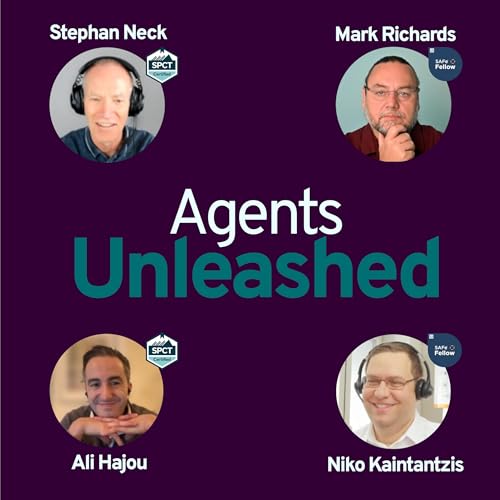“What the heck am I doing here? I’m just automating a shitty process with AI… it should be differently, it should bring me new ideas.” — Nikolaos Kaintantzis
Building AI Into the DNA of the Organization In this episode of SPCs Unleashed, the hosts contrast the sluggish pace of traditional enterprises with the urgency and adaptability of what they call “extreme AI organizations.” The discussion moves through vivid metaphors of camels and eagles, stories from client work, and reflections on why most enterprise AI initiatives fail. At its core, the episode emphasizes a fundamental choice: will organizations bolt AI onto existing systems, or embed it deeply into the way they operate?
Mark Richards reflects on years of working with banks, insurers, and telcos — enterprises where patience is the coach’s most important skill. He contrasts this with small, AI-driven startups achieving more change in three months than a bank might in two years. Stephan Neck draws on analogies from cycling and Formula One, portraying extreme AI organizations as systems with real-time coordination, predictive analytics, and autonomous responses. Nikolaos Kaintantzis highlights the exponential speed of AI advancement, reminding us that excitement and fear walk together: miss the news for a week, and you risk falling behind.
Actionable Insights for Practitioners 1. Bake AI in, don’t bolt it on. Enterprises often rush to automate existing processes with AI, only to accelerate flawed work. True transformation comes when AI is designed into workflows from the start, creating entirely new ways of working rather than replicating old ones.
2. Treat data as a first-class citizen. Extreme AI organizations treat data as a living nervous system — continuous, autonomous, and central to decision-making. Clean, structured, and accessible data creates a reinforcing loop where the payoff for stewardship comes quickly.
3. Collapse planning horizons. Enterprises tied to 18-month or even quarterly cycles are instantly outdated in the world of AI. The pace of change demands lightweight, experiment-driven planning with rapid feedback and adjustment.
4. Build culture before capability. AI fluency is not just a tooling issue. Extreme AI organizations cultivate a mindset where employees regularly ask, “How could AI have helped me work smarter?” This culture of reflection and experimentation is more important than any single tool.
5. Keep humans in the loop — for judgment, not effort. The human role shifts from heavy lifting to guiding direction, evaluating options, and applying ethical oversight. Energy is conserved for judgment calls, while AI agents handle more of the execution load.
Conclusion Enterprises may survive as camels, built for endurance in their chosen deserts, but the organizations that want to soar will need to transform into eagles. Strapping wings on a camel isn’t a strategy — it’s a spectacle. The path forward lies in embedding AI into the very DNA of the organization: data as fuel, culture as the engine, and humans providing the judgment that keeps the flight safe, ethical, and purposeful.
 1 hr
1 hr 1 hr and 1 min
1 hr and 1 min 58 mins
58 mins 58 mins
58 mins 59 mins
59 mins Oct 13 20251 hr and 2 mins
Oct 13 20251 hr and 2 mins 58 mins
58 mins 1 hr and 3 mins
1 hr and 3 mins

